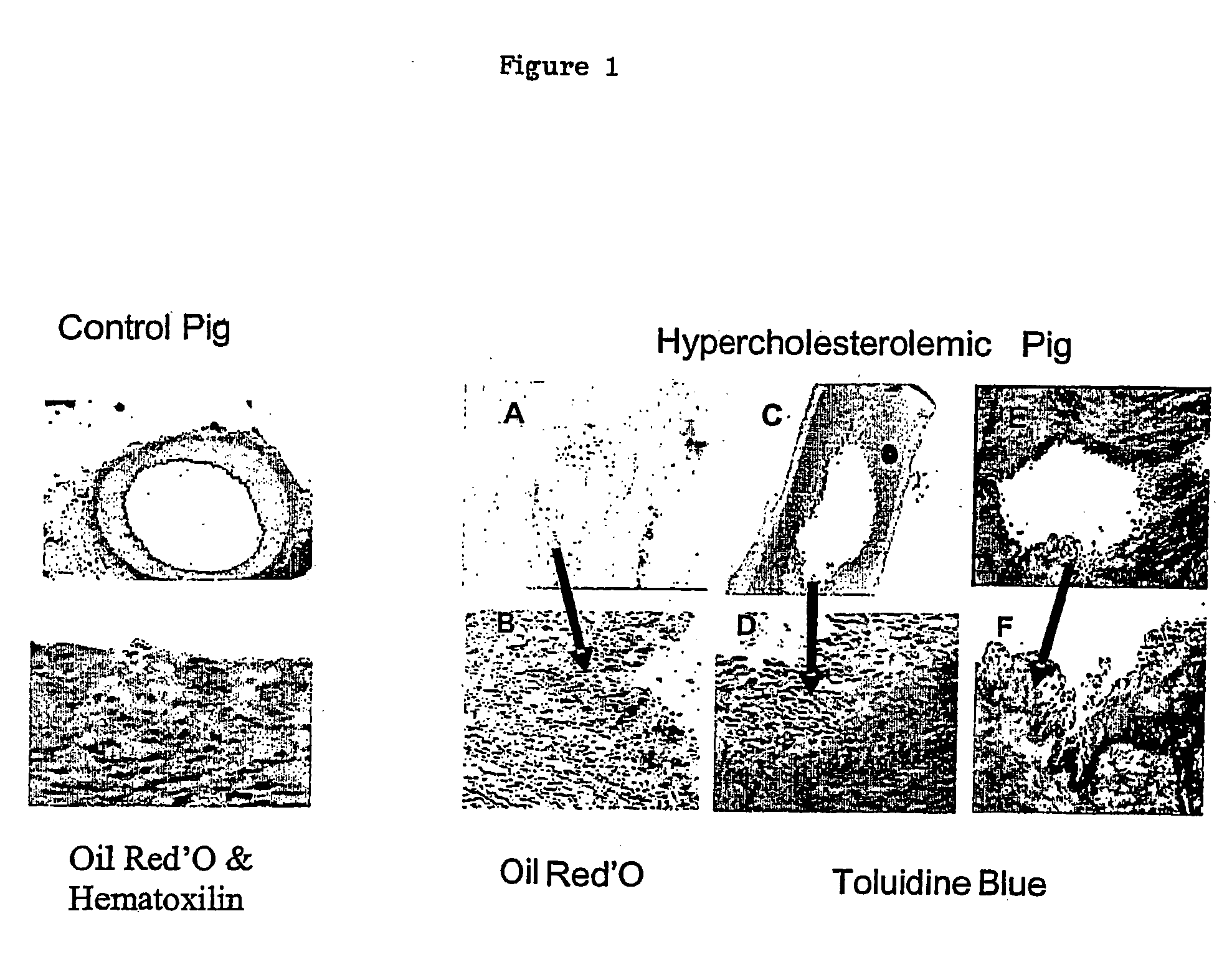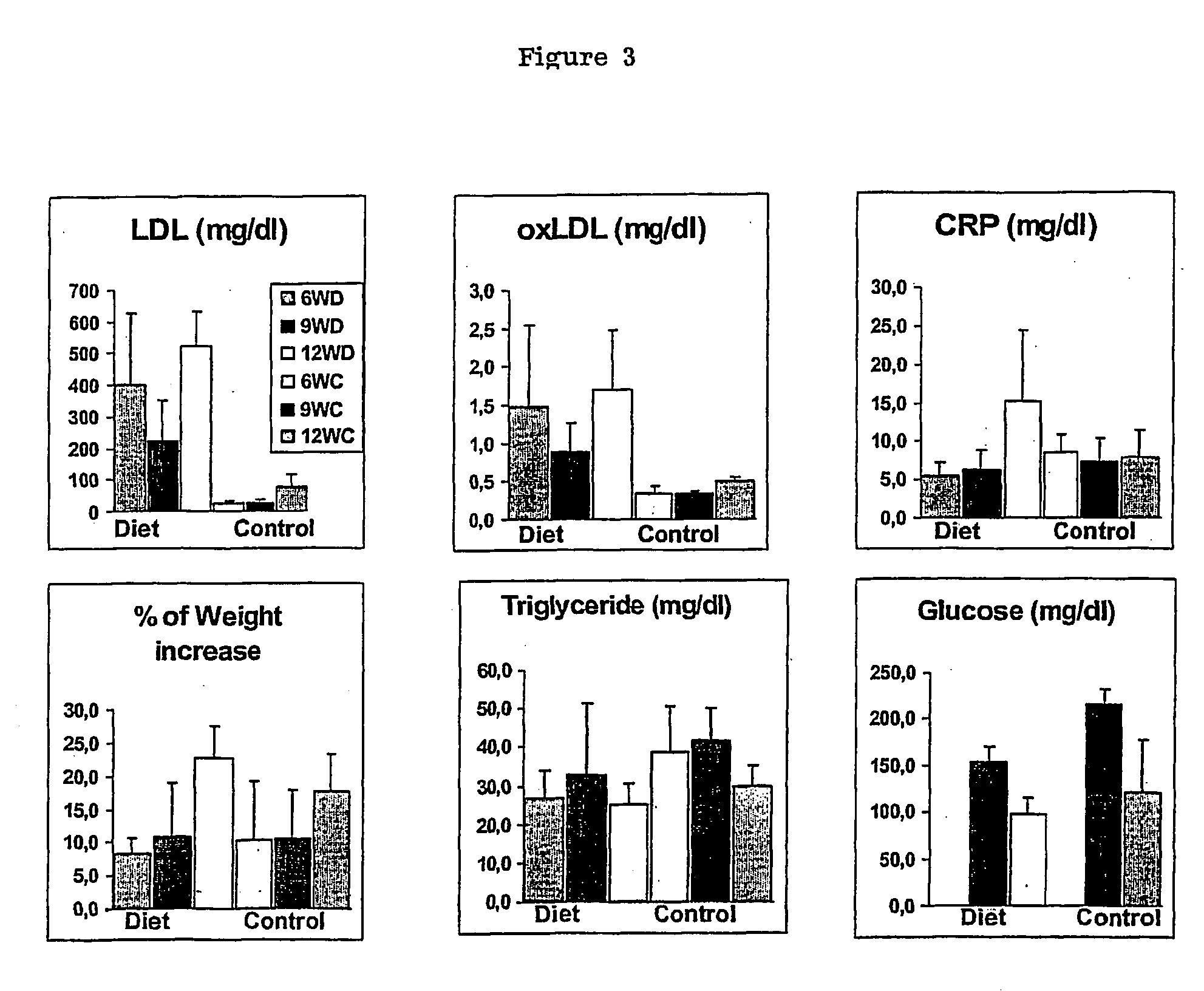Methods and composition for identifying therapeutic agents of atherosclerotic plaque lesions
a technology of atherosclerotic plaque and therapeutic agent, applied in the field of cellular biology and pharmacology, can solve the problems of endothelium dysfunction, pathologicity, and contributing to arterial plaque destabilization
- Summary
- Abstract
- Description
- Claims
- Application Information
AI Technical Summary
Benefits of technology
Problems solved by technology
Method used
Image
Examples
example 1
Animal Model and Sample Preparation
[0087] Differential gene expression analysis during the progression of an atherosclerotic plaque may be applied to a variety of animal models for the detection of co regulated pathways that may constitute targets implicated in the growth and the erosion of atherosclerotic lesions. These animals may be used for screening or validation of molecules that can modulate the differential expression of at least two of the protein chosen among Stearoyl CoA desaturase, Phosphatidic acid phosphate, and Phosphoinositide-specific-phospholipase-B1, in association or not with at least one protein among Aldose reductase and aldehyde reductase, Sphingomyelinase, Acid ceramidase, Ceramide glucosyl transferase, Sphingosin phosphate liase, Thymosine beta 4, Aldehyde dehydrogenase, ATPase Ca++ binding protein and CD163 at the level of an arterial plaque. Animal based systems may include non genetic and genetic modified animals such as, but not limited, pigs, mouse, ra...
example 2
[0121] Differential expression of genes in a given sample can be monitored with different technologies including, traditional northern blot, RT-PCR, and differential display. However, methods and assays of the invention are most efficiently designed with array and DNA-chip technologies.
[0122] Any hybridization format may be used, including solution based and solid support based formats. In the present example, a high density array of DNA probes on a solid support was preferred with the following protocol.
[0123] 1) Preparation of Pig Universal Reference
[0124] A pig universal reference was made. Total RNA was extracted with Qiagen RNeasy (Qiagen) from 8 swine control organs, including the heart, brain, lung, liver, kidney, spleen, thymus, and aorta. Total RNA from each organ was amplified as indicated before for microdissected samples. Finally, the Pig Universal Reference was made by equimolar mix of aRNA (first round and second round) of 8 swine control org...
example 3
Novel Genes Associated with the Progression of an Atherosclerotic Plaque
[0143] A—PCA Analysis of Gene Expression Data
[0144]FIG. 7 illustrates a factorial analysis of 24 different pigs with 1200 genes that were stastically up and down regulated during the progression of an arterial plaque. Stastical analysis was performed to evaluate lacking values with k nearest neighbours method (k=10) followed by a bilateral student test (1%) with Welch approximation (without ratio threshold). This method allowed the identification of significantly deregulated genes between the different pigs. The PCA method was used to transform a 24×1200 matrix into a 24×1 matrix. This analysis clearly shows that the diet minipigs can be clustered into three separate groups. Group 1, 2 and three can also be associated with different phenotypic attributes such as the amount of lipid present in the plaque, and the size of the plaque. Gene expression analysis of these different groups clearly establishes the asso...
PUM
| Property | Measurement | Unit |
|---|---|---|
| temperature | aaaaa | aaaaa |
| humidity | aaaaa | aaaaa |
| size | aaaaa | aaaaa |
Abstract
Description
Claims
Application Information
 Login to View More
Login to View More - R&D
- Intellectual Property
- Life Sciences
- Materials
- Tech Scout
- Unparalleled Data Quality
- Higher Quality Content
- 60% Fewer Hallucinations
Browse by: Latest US Patents, China's latest patents, Technical Efficacy Thesaurus, Application Domain, Technology Topic, Popular Technical Reports.
© 2025 PatSnap. All rights reserved.Legal|Privacy policy|Modern Slavery Act Transparency Statement|Sitemap|About US| Contact US: help@patsnap.com



